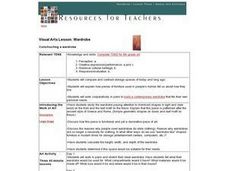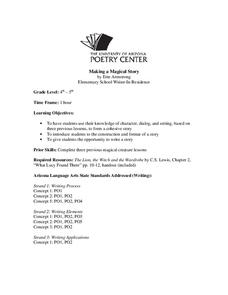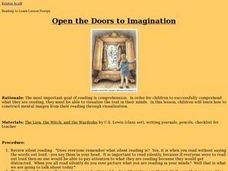Curated OER
Constructing a Wardrobe
Sixth graders compare and contrast storage spaces of the past and present. They examine how furniture tells us how people lived, and work in pairs to design and construct a contemporary wardrobe that fits their personal needs.
Curated OER
Narnia Bar Charts
Here is a fabulous presentation that combines math and literature. Learners construct bar charts and frequency charts about things that happen in Narnia. Student pairs are assigned tasks regarding the variety of characters found in the...
Curated OER
Visual Arts Lesson -Wardrobe
Students define the term neoclassism and locate examples of it in furniture design. They research and explain the role of the wardrobe in viceregal Mexico. Pupils compare and contrast the use of wardrobes as storage in the earlier...
Curated OER
Making a Magical Story
Students create their own magical story. In this story writing lesson, students listen to the story The Lion, The Witch, and the Wardrobe b C.S. Lewis to find the basic elements of a story. They come up with their own magical characters,...
Curated OER
Lion, Witch, Wardrobe
Students read the story of "The Lion, the Witch and the Wardrobe." Based upon the story, students perform reinforcement and discovery activities, according to their ability level. Pupils may write an essay, perform computer research,...
Curated OER
Making a Magical Story
Fourth and fifth graders use their knowledge of developing character, dialogue, and setting to produce an original story. An excerpt from The Lion, The Witch, and The Wardrobe is used as inspiration to get everyone's creative juices...
Curated OER
Buzzing Bee's Wardrobe
Young scholars investigate the anatomy of honeybees. In this anatomy lesson, students research the physical characteristics of bees and discover what they do. Young scholars create a model of a honeybee showing the correct anatomy.
Curated OER
Wardrobe
Sixth graders examine the concept of symmetry and balance. They view a wardrobe with an inlaid design, then design and create a symmetrical pattern using two different colors of construction paper.
Curated OER
Wardrobe
Sixth graders observe the wardrobe and discuss the role of the wardrobe in the culture of viceregal Mexico. They research the design and the influence of Moorish decoration in the geometric pattern on the door. Students identify...
Curated OER
The Lion, The Witch, and The Wardrobe: A Literature Evaluation Project
Sixth graders read and analyze The Lion, The Witch, and The Wardrobe. They study the elements of literature found in the book. Students create an elements of literature flip book that shows the various elements of literature in the novel.
Curated OER
Open the Doors to Imagination
Students practice visualizing what they read and hear in a text. They listen to selected passages from The Lion, the Witch, and the Wardrobe read by the instructor. Students discuss the visual pictures they see when listening to the...
Balanced Assessment
House Plan
A short assessment has individuals determine the scale of a house plan. They use the scale to calculate the size of a door and window that need to be replaced, and then divide a bedroom in two, calculating the size of rooms created.
Curated OER
Bench
Sixth graders examine and discuss the marquetry ornamentation on an antique bench. They design and create a symmetrically designed jewelry box using marquetry techniques.
Curated OER
Penny's Box
Students need to be able to calculate the volume and surface area of a cuboid as well as present a systematic list of results in order to justify the minimum case. The use of three factors of 100 is also important.















